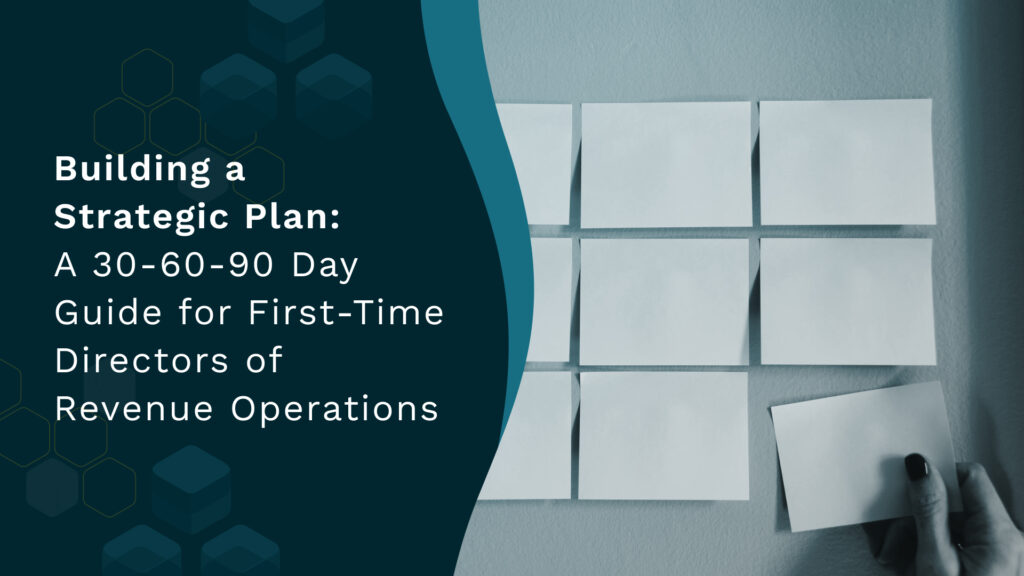
Meddic Sales Methodology Guide 2025: Everything That You Need to Know
Discover the MEDDIC Sales Process Guide for 2025: a comprehensive overview of the methodology, key components, and strategies for sales success.
Sales teams are ambitious; there are no two ways about it. That’s why they want to continually succeed.
45% of sales professionals cited exceeding targets as a top priority.
But they may not necessarily taste success in all quarters.
If your sales team is facing a similar narrative—struggling to close deals—or simply wants to level up their game, introduce them to the MEDDIC sales process.
Because sometimes, it’s not the sales pitch to blame but the wrong target audience. 71.4% of sales professionals say that only 50% or fewer of their initial leads are a good fit for their ICP.
MEDDIC can solve the problem by helping you understand the customer at each stage of the sale and making it easier to win more deals.
So, press pause on the underperforming selling tactics and read this guide on the MEDDIC sales process.
What is the MEDDIC sales process?
The MEDDIC Sales Process is a B2B sales qualification methodology that high-performing sales teams use to drive revenue and business growth.
Instead of selling to make money, the MEDDIC sales process focuses on improving the customer experience by working with better-qualified leads who are the right fit for your product.

This sales qualification process was first developed by Jack Napoli and Dick Dunkel at Parametric Technology Corporation (PTC) in the 1990s. They used the technique to triple sales from $300 million to $1 billion in just 4 years.
The term MEDDIC has evolved with time, accounting for newer steps in sales qualification, and is now synonymously known as MEDDICC and MEDDPICC.
Why use the MEDDIC sales process?
Top performers aren’t better at one thing or another; they’re masters of all of it. They’ve mastered discovery. They’ve mastered pain-based solutions and demoing. It’s like – I’m going to isolate things to three vignettes tied to the problem. I’m going to tell you exactly what I’m about to show you. I’m going to nail it directly to what I learned in discovery. We’re then going to unpack it, implicate it, and (build a) business case around it.
David weiss, founder, deal doc & cro, the sales collective
And that’s why MEDDIC is a frontrunner in mastering the art of selling to the right audience.
Here are 11 more reasons why you should use the MEDDIC sales process:
- Through in-depth qualification, it helps assess if a buyer is a good fit for you.
- It gives you a clear breakdown of the steps involved in buyer decision-making.
- Your teams receive in-depth knowledge of customers to establish a well-defined target audience.
- It simplifies the selling process by using buyer information over conventional promotional tactics.
- It gives your team access to crucial stakeholders.
- You can build better forecasts by predicting when deals will close.
- It helps you allocate resources efficiently and save time.
- It successfully guides reps through potential roadblocks before they turn into huge problems.
- Your teams follow a common language framework, maintaining alignment.
- It boosts closing rates.
- Finally, MEDDIC empowers the buyer group to understand the unique value of your solution compared to competitors.

Diving Into the MEDDIC sales methodology
MEDDIC is an acronym of the terms involved in the process. Let’s get to the bottom of each.

1. Metrics
Metrics: Quantify the value your product offers the customer. This value is defined in the form of goals or objectives the buyer seeks to achieve.
Simply put, it aims to answer the question, “Why does your customer want to buy the product?”
Instead of focusing on irrelevant or vague product benefits to answer this question, you must get specific using metrics. In the MEDDIC sales methodology, metrics are the best way to prove how much ROI you can provide the customer.
For example:
- Increase employee productivity by 50%
- 2x increase in output, decreasing time-to-market by half
- Improve critical query resolution by 200%
It’s important to focus on metrics that match your customer’s needs. Avoid throwing a long list of metrics in their face to show off your success.
Once you know which metrics serve the customer, you can better explain how your solution will help them achieve their business goals.
This ensures you create a positive impression on the buyer.
According to 56% of sales leaders, being engaged and attentive is the top way to gain a client’s trust. An engaged sale results in a much more productive discussion where you can find their needs, challenges, and goals and shape these into metrics.
So, how do you determine the right metrics for your buyer using the MEDDIC sales methodology? Here are some qualifying questions you must ask.
Qualifying questions for the buyer:
- What goals do you want to achieve?
- How do you track your performance currently?
- What would successful outcomes of these goals be for you?
- How much are you willing to spend to achieve your goals?
Qualifying questions for you:
- Does your buyer have defined goals or objectives?
- Will your product have a quantifiable and measurable impact on their goals or objectives?
- Can you share more metrics from previous instances with the customer to help understand your impact? (without overwhelming them)
Prove your expertise:
Use metrics to show case studies and proof of work from existing customers to your leads.
Describe the problem in the case study and how your product solved it. And substantiate the value the customer acquired in the form of metrics.
Discussing a real business use case opens the floor to understanding real impact.
2. Economic Buyer
Economic Buyer: Responsible for authorizing financial decisions related to the deal.
In the MEDDIC sales process, their final word can make or break the deal because they can say “no” even when others say “yes” or the other way around. And more than half (55%) of sales professionals consider budget as the first or second-most common reason for stronger opportunities to fall apart in sales.
The Economic Buyer has control over the buyer’s budget and complete discretion over funds. They also follow a largely business-centric mindset focusing on the big picture and profit and loss.
Engaging with the Economic Buyer is even more important in the current business environment. They are under immense pressure from the lack of funding and pressure to prioritize projects.
Appeal to the Economic Buyer with the MEDDIC sales methodology by identifying their requirements and motivation. And show them how your product offers the strategic value they seek.
If possible, engage with them in a one-on-one conversation about their goals and purchase criteria. But if this isn’t possible, gather relevant information from your contact.
Look out for misidentification. Your contact may sometimes assume they’re the Economic Buyer since they own the budget. But if someone else can control this budget, that’s your Economic Buyer.
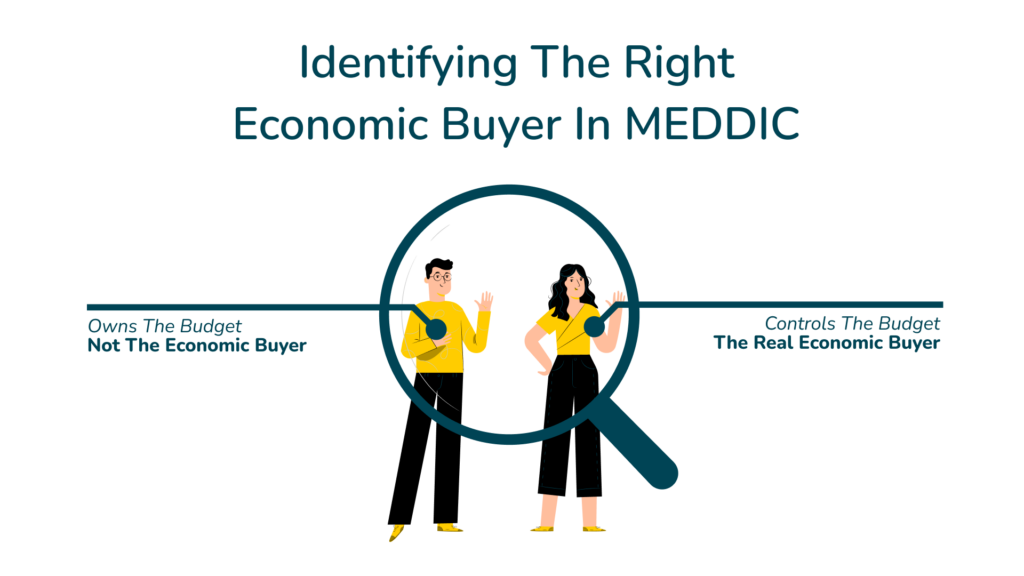
Qualifying questions for the buyer:
- What is your role in the decision-making process? Are you responsible for vetoing the project?
- What are your strategic priorities and metrics?
- What do you need to approve a product?
- Is there a defined budget?
- Do you own the budget and will be the one signing the contract?
Qualifying questions for you:
- Can your contact secure funds for unplanned investments?
- Can they approve the new budget if you convince them that a higher spending amount will bring greater ROI?
- Are your contact’s business goals aligned with the company?
- Does your contact have the authority to say yes or no if other stakeholders disagree?
Prove your expertise:
The Economic Buyer isn’t interested in your product’s features or functionalities. They’re most interested in the ROI you can bring in, directly impacting their bottom line.
So, don’t hold back from leveraging your leaders or team in the MEDDIC sales process to convince them of your effectiveness.
3. Decision Criteria
Decision Criteria: Buyers generally have guidelines or a list of criteria used to vet multiple vendors called Decision Criteria.
In the MEDDIC sales process, Decision Criteria are the factors or criteria that influence the buyer’s decision-making.
Knowing these specific criteria helps your reps craft a persuasive pitch. You can convince the buyer how your product meets their Decision Criteria and provides unique value without harping on product features.
As is proved, top sales performers discuss product features far less—only 9% of the time—compared to other sellers at 18%.
Other than shaping your pitch, Decision Criteria also give you insight into how your buyer decides on similar products or services (competitors).
As per the MEDDIC sales process, these criteria fall into 3 categories as below:
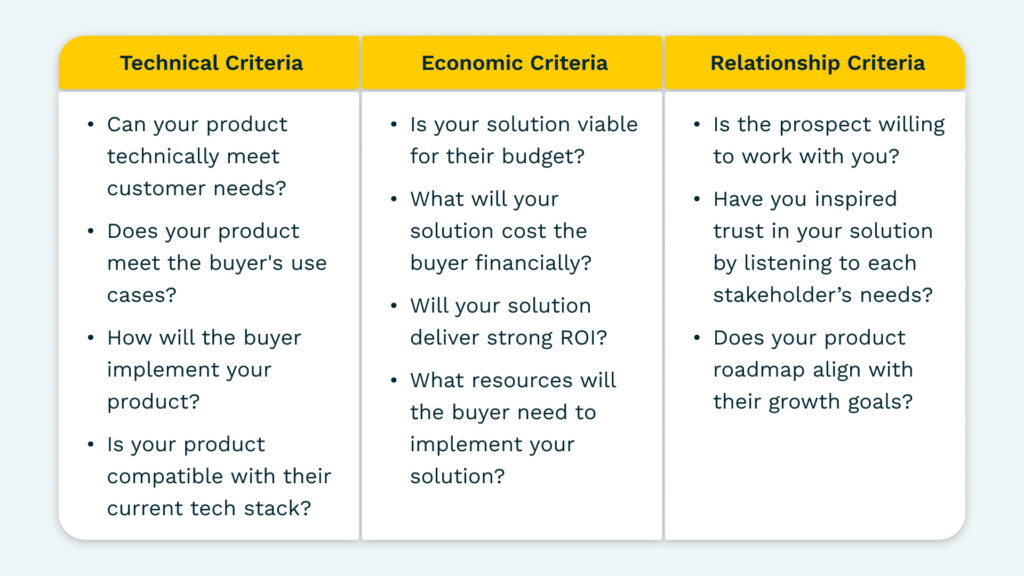
Qualifying questions for the buyer:
- Why are these criteria important?
- What are the key ones you must meet?
- What do you need to see to make the final decision?
Prove your expertise:
If your buyer doesn’t have comprehensive Decision Criteria, request them to write them down.
This is an excellent opportunity to align their Decision Criteria with your product’s strengths by helping them build the list.
4. Decision Process
Decision Process: Lays down the steps they use to reach a decision and, more importantly, implement that decision.
Putting it simply,
Decision Criteria = Answers the “what” behind a sale
Decision Process = Answers the “how” behind a sale
The Decision Process involves 3 primary elements.
- Decision maker: Who will make the decision
- Timeline: The time needed to make that decision
- Procedures: The formal approval processes to be followed
Further, it’s divided into two parts—technical validation and business approval.
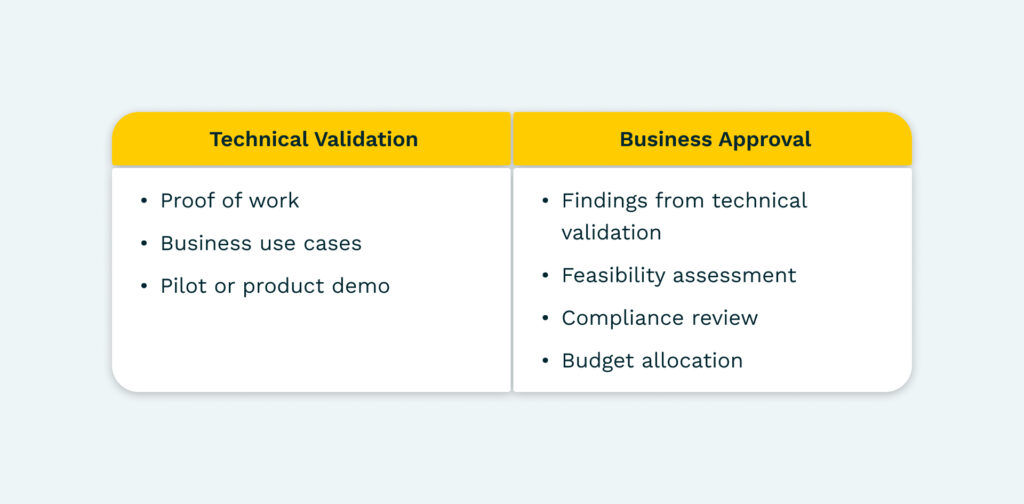
Qualifying questions for the buyer:
- What is the process followed before authorizing a deal?
- What are the critical terms you must meet?
- How much time does the decision process generally take?
- What is the paperwork expected?
- Who is responsible for the final decision, and which other stakeholders will be involved?
Qualifying questions for you:
- Is the buyer’s timeline realistic to pursue?
- Does the buyer have a structured decision-making process?
- Are all the key stakeholders involved in the decision process?
Prove your expertise:
Since each buyer follows a different Decision Process, you can’t assume a general step in the process will close or lose the deal.
Knowing the Decision Process helps identify the areas where things could go wrong for a particular buyer. Then, consistently work with the buyer to advance the deal through the MEDDIC sales process stages.
5. Identify or Implicate Pain
Implicate Pain: A "pain point" is a problem serious enough for the buyer to seek a suitable solution. Higher the pain, higher the value of a solution, and higher the priority for you.
For instance, if the buyer says their forecasting is poor, that’s a weak pain point. But if the buyer says they need to improve forecasting by 200% in the next 6 months, their problem is serious.
Other areas where buyers need help could be:
- Low sales productivity
- Revenue leaks
- Slow production
- Inefficient delivery process
The MEDDIC sales process classifies buyer pain points into 3 types—financial, efficiency, and people.
Implicate pain by conducting qualitative market and competitor research, and using customer feedback on the buyer’s product. You can then identify their biggest pain points and proposition your product as an effective solution.
Qualifying questions for the buyer:
- What is holding you back from achieving your objectives?
- What could go wrong if you didn’t find a solution?
- How soon is the pain going to become a serious hindrance?
- What’s the financial value you can attach to your pain?
- If money is out of the question, what pain will you solve first?
- Who benefits from removing these obstacles?
- Have you tried any solutions before? If yes, what were they?
Qualifying questions for you:
- Is your buyer’s pain urgent enough to accelerate the sales cycle?
- Is their pain very specific?
- Will your solution effectively solve their problem?
Prove your expertise:
Don’t just identify the buyer’s pain and prop up your solution’s benefits. Be open to deep diving into the problem’s effect on their business.
Help the customer see the pain point clearly enough before introducing your solution.
6. Champion
Champion: The person most invested in your solution. They want to see the deal succeed and will advocate and act as an internal seller on your behalf.
Having a Champion on the buyer’s side is a game changer in the MEDDIC sales process.
The Champion may not necessarily be a leader, manager, supervisor, or Economic Buyer. But they must have considerable influence over the stakeholders and be well-established in the buyer’s organization.
For example, if you’re selling a customer support solution, your Champion may be the Customer Success Manager who will use your product. The Economic Buyer, on the other hand, could be the finance or admin head who’s more interested in the ROI.
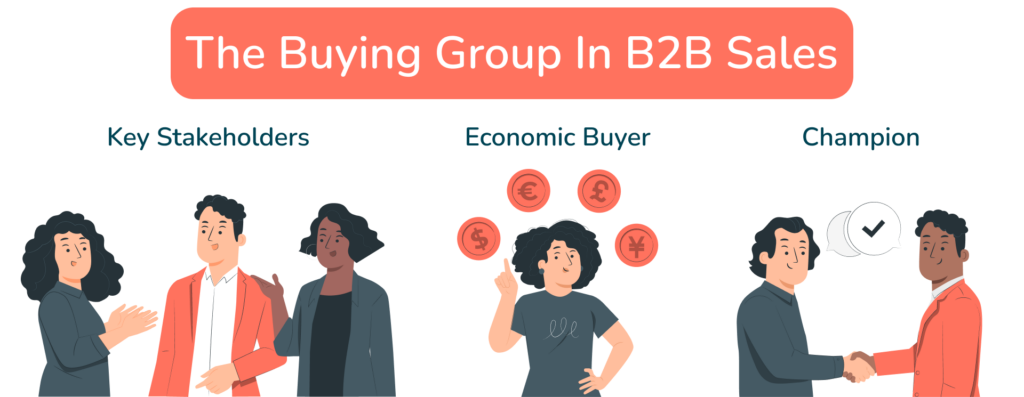
Discover your Champion, get to know them, and help them see the value in your product.
Provide them with necessary resources like demos, case studies, reports, and subject matter experts to address their technical questions.
Qualifying questions for the buyer:
- Who in your organization will benefit the most from this product?
- How well-connected are you with key stakeholders?
- Why do you need to purchase this solution right now?
- Have you purchased or used something similar to this product before?
Qualifying questions for you:
- Do they carry enough influence on key stakeholders, including the Economic Buyer?
- Can they offer inside information on which way the buying group sways?
- Will they support your solution even when you’re not around?
- Is anyone championing your competition? Who is it, and what influence do they hold?
Prove your expertise:
Building trust is crucial to getting the Champion to bat for you. Be consistent, reliable, honest, and approachable with them.
Also, recognize and celebrate their effort in backing you. This makes them feel a sense of ownership in the project.
How Is MEDDPICC Different From MEDDIC?
As businesses evolved, sales teams added two elements to the MEDDIC sales process.
1. Paper Process
While Paper Process is somewhat covered under Decision Process, several deals involve tons of paperwork, necessitating a separate step.
65% of businesses experience delays in closing deals relating to contract management issues.
Paper Process encourages reps to get ahead of complicated paperwork—legal agreements, compliance requirements, and procurement documentation—that could delay a sale.
2. Competition
Given today’s competitive B2B landscape, it’s no surprise to see Competition occupy a place of its own in the MEDDIC sales process.
It helps reps discover which competitors the prospect is evaluating and gauge how the buyer feels about these alternatives.
It also gives you an idea of competitors’ value propositions and how to position yourself as the better alternative.
Master the MEDDIC Sales Process With Nektar
MEDDIC must be embedded in the entire selling process to succeed. But this needs qualitative adherence.
Sometimes, reps may forget to enter the right information in the CRM. It becomes a drawback when poor data hygiene, friction-filled handoffs, and inefficiencies affect selling.
Gathering clean data is important to implement as well as master the MEDDIC sales process.
Unified data lets you focus on the right prospects by:
- Ensuring complete contact data
- Identifying the Economic Buyer and Champion early
- Identifying the Decision Criteria
- Formulating the Decision Process
- Implicating pain to show your product’s distinct value
When you have complete visibility, you can also evaluate why a deal gets stuck or replicate wins. In doing so, you can motivate your reps to continue working to their strengths and improve productivity.
Nektar’s solution allows you to power your selling process with unified data and master the MEDDIC sales process. Connect with our team to find out more!
PUBLISHED BY



